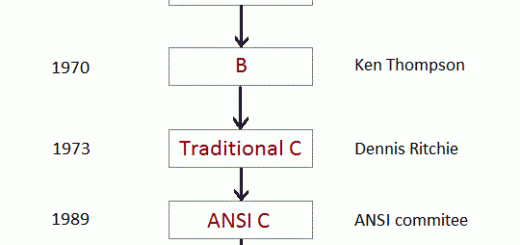The console function like printf() and scanf() have been used for input/output .This scheme is adequate if the volume of data involved in not so large or it is not necessary to store the information for further use. However, many applications may require a large amount of data to be read, processed, and also saved for later use. Such information is stored on the auxiliary memory device in the form of a data file.And a file is a collection of bytes that is given a name. In most computer systems, files are used as a unit of storage primarily on floppy-disk or fixed-disk data storage system (or they can be CDs or other storage devices). Thus data files allow us to store information permanently, and to access and alter that information whenever necessary. The file handling function available in the standard library in order to implement I/O model is classified as follows:
a) File access
b) Operation input/output
c) Formatted input/output
d) Character input/output
e) Direct input/output
f) File positioning
g) Error handling
The file access included the function like fopen() to open a file, fclose() to close a file, fflush () to flush out the buffer associated with a file, and freopen() to change the file associated with a stream. Also, setvbuf() and setbuf() functions are used to allow the users explicitly control the file buffering strategy. The operation on file includes like remove() to remove a file, rename() to rename a file ,tempfile() to create a temporary binary file and tmpnam() to generate a unique filename. Formatted input/output group includes the n functions fscanf(), scanf() and sscanf() to read formatted data. Similarly fprintf() ,printf(), sprint(), vfprintf(), vprintf() and vsprintf() to write formatted data. The character input/output group includes the functions fgetc() ,getc() and getchar() to read a character from an input stream and functions ungetc() to push back a character to an input stream. The functions fgets() and gets() are to read strings and the output functions fputc(),putc(), putchar(), fputs() and puts() are also included in this group. The direct input/output group includes functions fread() to read and fwrite() to write a certain number of data items specified size. File positioning group includes functions fread() to read and fwrite() to write a certain number if data items specified size. File positioning group includes functions to set the file positon to some specified value to allow access to a specific portion of the seek(),interrogate the current file position ftell(),and reset the file position to the beginning of the file rewind(). Error handling group include functions to test whether EOF returned by a function indicates an end-of-file or an error (feof and ferror), clear end-of-file and indicators clearer, and map the error number errno to an error message perror.
File Accessing:-
To work with file using any file handling library functions, C requires a pointer to structure FILE defined in <stdio.h>.The declaration of file pointer is done as follows:
FILE *fptr;
This declaration creates a variable fptr, which is pointed to the FILE structure. The pointer to the FILE structure is also called file pointer. The FILE structure describes the current state of a file such as a file status flag, file descriptor, file buffer etc. There are also predefined file pointers such stdin, stdout, and stderr which refers to standard input (normally keyboard), standard output (normally monitor) and standard error (connected to screen for error handling). The file access functions provide the facilities to open and close a file, flush out the file buffer, change the file content and control the file buffering strategy. Before working with a file it should be opened first. To open a file and associate it with a stream, we use fopen().Its prototype is shown here:
FILE *fopen(char *fname,char *mode);
The fopen() function, like all the file-system functions ,uses the header <stdio.h> .The name of the file including the path is specified by fname and the mode specifies how file is accessed. Both of these parameters are a string. The string specifying the mode is shown in the following table.
| S.N | Mode | Meaning |
| 1 | “r” | Open a text file for reading |
| 2 | “w” | Create a text file for writing |
| 3 | “a” | Append to a text file |
| 4 | “rb” | Open a binary file for reading |
| 5 | “wb” | Open a binary file for writing |
| 6 | “ab” | Append to binary file |
| 7 | “r+” | Open a text file for read/write |
| 8 | “w+” | Create a text file for read/write |
| 9 | “a+” | Append or create a text file for read/write |
| 10 | “r+b” | Open a binary file for read/write |
| 11 | “w+b” | Create a binary file for read/write |
| 12 | “a+b” | Append a binary file for read/write |


